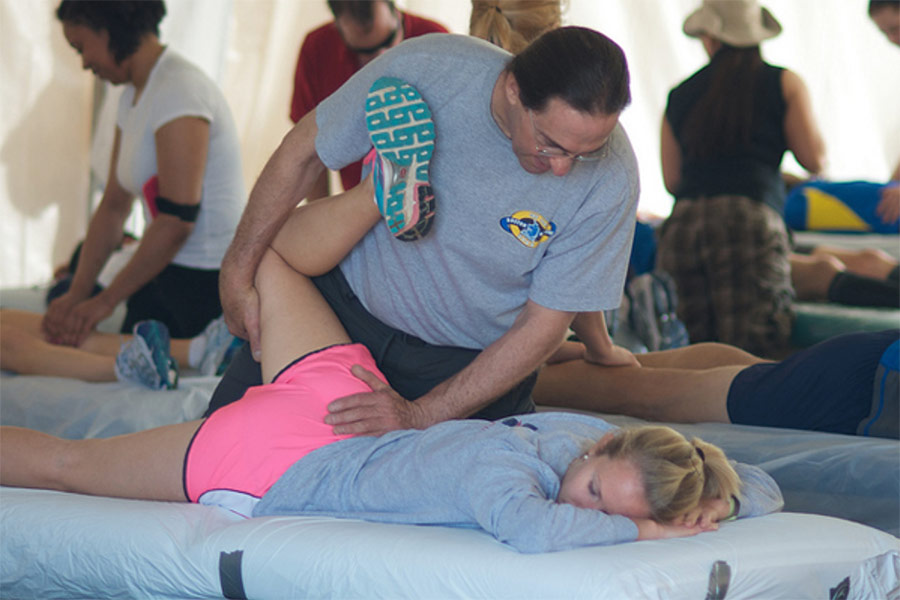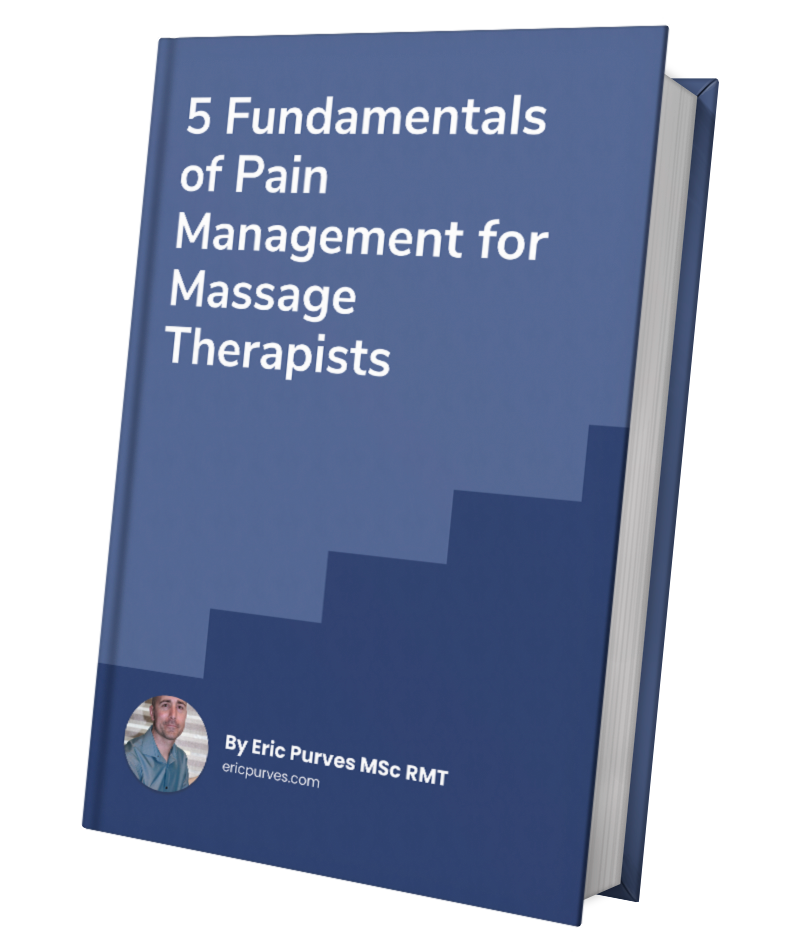When I graduated from massage therapy school in 2005 I had already completed my bachelor of science and felt very comfortable in my knowledge and abilities to become a great therapist. It became very evident to me over the ensuing years that there was a lot more I needed to know and understand in order to more effectively treat complex problems, particularly those who lived with persistent pain.
It was through the experience of seeing my wife struggle with disabling pain and realizing the treatments she was receiving from medical doctors and allied health care providers were inadequate.
Something was missing in how myself, and other health professionals were educated.
The conceptual framework and understanding of the human pain experience and how we conduct our treatments appeared incomplete.
This quest for answers led me on a fantastic journey that completely changed how I view the human body, the brain, the neuroimmune system, how I communicate, clinically reason and treat my patients. When I attended the first San Diego Pain Summit (Feb 2015) I was convinced that the path I was pursuing was the least wrong one available.
Treating people in pain is what we do, and there is a much better way to do it than what we learn in school. I felt inspired and realized one of the main problems with our profession is that there are not enough of us with advanced degrees to lead the profession towards the changes it needs.
I decided that in order to help advance our profession I couldn’t sit on the sidelines, I would need to be involved and pursued more education. That September I started my Masters in rehabilitation sciences at the University of BC.
Already, in a short period of time I feel I have gained invaluable tools for critiquing research, finding and utilizing evidence for practice and critical thinking skills. These skills need to be fundamental to all health-care professionals.
Changes are necessary for us to evolve.
National Standards For Massage Therapists
The profession of massage therapy in Canada (particularly in British Columbia), has a long history of being leaders in its curriculum, standards of education and licensure that can exceed our colleagues in other parts of the world.
There is a strong desire among our membership in BC to increase our education to that of a baccalaureate program. Our professional association, the RMTBC has completed great work in attempting to make this happen. Ideally, it would be great if all education for massage therapists was standardized regardless of what province or state you were educated in, much like it is for physical therapists, nurses, pharmacists, opticians, and medical doctors.
Currently in Canada the regulated provinces are working on a national standard of competencies. I applaud their attempts in pioneering this endeavour as it could provide a framework that other massage therapy regulatory bodies throughout the world could follow. However, the lack of quality research used to support the development of the competencies is embarrassingly evident.
As a regulated health-care profession, the educational curriculum and practice standards of massage therapy need to be based on strong scientific principles and good quality relevant research. In order to make informed practice decisions and incorporate an evidence-based approach to treatment planning the educational standards of RMT’s must be recreated.
As it currently stands, the Interjurisdictional Competency Document and its companion, the Guidelines for Foundational Knowledge in Massage Therapy Educational Programs, which together form the framework of what is taught in the massage therapy colleges and creates the material for what is required to pass board exams, are both regrettably unacceptable as documents around which an entire profession’s competencies are created.
Creating A Greater Understanding Of Massage Therapy
What is wrong with this document and what is a fundamental problem in our profession?The primary faults I see is the research on the actual mechanisms of manual therapy are ignored and an inadequate understanding of pain and its bio-psycho-social components are missing.
Unfortunately, manual therapy professions base their treatment models and understanding of pain and dysfunction through out-dated biomedical beliefs, structuralism and connective tissues modalities. There is a better direction to go, we simply need to follow the science.
Manual techniques exhibit the majority of their effects based on mechanoreceptor input from the skin, not the muscles or fascia. The words we use, how we interact with our patients and the explanations we give are more important than any miraculous technique that we learn. This short article provides a great discussion of the need to move beyond our techniques.
All positive or negative changes our patients have in their pain perception or movements are from alterations in their nervous system. Nervous tissue is the only tissue in the body that can adapt and change quickly within the confines of a treatment session.
Once a therapist realizes that every effect we have is through the nervous system, primarily the brain, massage therapy becomes much more simplified, more powerful as a therapeutic tool and prevents unnecessary and unrealistic treatment plans that do not serve the best interests of the patient.
Research has shown that connective tissue cannot be altered for any length of time through manual techniques, and we shouldn’t want to alter it anyway. Here are a couple great articles worth the read that refutes fascia’s importance, here and here. I could post numerous links to all the research, but these two sum it up succinctly.
Trigger points, another sacred doctrine of massage therapy are likely not a problem in muscle tissue, more plausibly it is referred pain from peripheral nerves. Posture and biomechanics are not always as important as we think they are either, here is a free full text pdf available which is worth the read.
These links are not meant to completely invalidate other ways of thinking.
They are to identify the science and other opinions in the manual therapy field. As a profession we need to be more open-minded and become science-based clinicians, and not continue to base our curriculum and practices on historical beliefs. This is still possible while not forgetting the art of what it is we do.
Three Pillars Of Massage Therapy
The three pillars that guide our profession as outlined by our regulatory Colleges is safe, effective and ethical health care.
By purposely neglecting the wealth of evidence on manual therapy mechanisms we are failing on all three pillars. This purposeful neglect is unforgivable with the wealth of modern science on pain, fascia, biomechanics and the mechanisms of manual therapy.
By focusing on out-dated beliefs and a biomedical structuralist approach to care, and furthering the pseudoscientific beliefs about fascia, trigger points, cranio-sacral therapy, visceral manipulation, postural asymmetries and adhesions to name a few, we are supporting unsafe, unethical and ineffective practices.
Our profession needs to move towards an evidence-based model that includes plausible scientific principles of manual therapy.
We do not need to make up stories to explain what we are doing. Touch is therapeutic, massage and movement is analgesic. These effects occur because of our interaction with another person’s nervous system.
By adopting a curriculum that includes biopsychosocial approaches to pain management, peripheral and central mechanisms of pain, understanding nonspecific treatment effects, motor control, graded exposure to movement, principles of patient centred care and the pillars of an evidence based practice, we would be much better suited to provide safe, effective and ethical care.
Those approaches are much more supported by science and encourage a feeling of security, robustness and self-efficacy that can elicit more consistent results and better patient outcomes.
The problem with overcoming this dilemma is the belief systems are so ingrained in the profession. Too much of what we do is based on faith and not on fact. Changing the profession will require great force of will and continuous efforts, because it is an entire culture that will need to adapt and change.
From the top down, national massage therapy organizations, provincial regulatory Colleges’, massage therapy educator’s, current RMT’s, and students will need to adjust.
Changing Massage Therapist Focus
We are so focused on our modalities and learning new techniques to add to our toolbox, that we lose focus on what really matters.
Our profession has made the care we provide more complex than it needs to be.
If we could focus on having a solid foundation in the core sciences, learn how to interpret research, critically think, and learn advanced skills to more effectively interact and educate patients we would be significantly farther in our progression as a useful component of the health care system.
Patient centred care and evidence-based practices should be the foundation of what we learn in our education. Assessment and manual skills are important and these skills will always be central to our profession. RMT’s can still historically do what we have always done, but the time is here for us to adapt and reinvent ourselves. The regulatory Colleges, professional associations, all the private colleges and most importantly the massage therapists have roles to play in this process and a desire from each organization or individual to implement change is needed for our profession to become leaders in manual therapy education.
Change is constant, it is not to be feared, and it needs to be embraced, as change is necessary for the long-term survival and relevancy of our profession.
Visit Somasimple.com, Body in Mind at http://www.bodyinmind.org, the NOI Group athttp://noijam.com, www.greglehman.ca, or go on Facebook and interact with clinicians from Skeptical Massage Therapists, Biopsychosocial therapists or Explaining Pain Science among many others and you will find great debate, discussion and heaps of research to sift through that will quickly get you questioning your current practice and beliefs.





